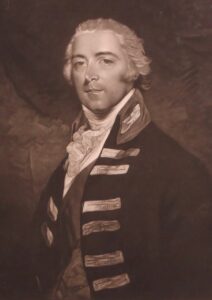PITT, John, 2nd Earl of Chatham
10 October 1756 – 24 September 1835
Ensign 47th Foot March 1774 to General 1812
First Lord of Admiralty, 1778-1794, Lord Privy Seal, Lord President of the Council, Governor of Jersey 1807-1820, Governor of Gibraltar 1820-1835
Early life
John Pitt was born at Hayes Place on 10 October 1756. He was the eldest son of William Pitt the Elder, 1st Lord Chatham, and his wife Hester (née Grenville). His father wrote to his nephew Thomas with the news: “I have the pleasure to acquaint you with the glad tidings of Hayes. Lady Hester was safely delivered this morning of a son”. He commented to George Grenville on his health and size: “the young man meets with general applause for stature and strength”. John was baptised the same year at Hayes Church on 7 November. His elder sister Hester had been born a year earlier and another sister Harriot was born in 1758. The following year saw the birth of his brother William whose later political career would overshadow John, who from an early age was destined to join the army.
Letters from their mother reveal the delight that the children found in simple pursuits in the grounds of Hayes Place. She told of Hetty and John chasing butterflies and in 1760 the children rejoiced with their mother over the news of the victory at Torgau. John aged four shouted “Hurrah”. The next year his brother James was born. The children were all educated at home by Revd Edward Wilson and their mother reported John’s achievements in her letters to her husband. In 1766 she wrote, “John was distinguished first for his mathematics and then for his Latin lesson.” His drawing was also good and he loved dancing which he was taught along with his brothers and sisters by dancing master Giovanni Gallini. Throughout his life he loved riding and shooting. His parents considered but decided not to send him to Eton. He continued to be taught by Edward Wilson until his father secured him a position as an ensign in the 47th Foot. In 1774 his army career commenced when he travelled out with Sir Guy Carleton to Quebec. He took part in many overseas campaigns, with mixed fortune, but rose to the position of General by 1812.
Honeymoon at Hayes
Following the death of his father at Hayes Place in 1778, John became the 2nd Earl of Chatham. He married his childhood sweetheart, Lady Mary Townshend, at her father’s London house at Albermarle Street, St. George Hanover Square, on 10 July 1783 and they honeymooned at Hayes Place.
Mary, now Countess of Chatham, was the daughter of Thomas Townsend MP, 1st Baron Sydney, after whom the city of Sydney, Australia, is named. He was a political supporter of Pitt the Elder and later held key government positions in Pitt the Younger’s government. As Home Secretary, Townshend was responsible for plans to send convicts to Botany Bay in Australia and the Governor he appointed honoured his patron by naming Sydney Cove after him. The Townsends lived at Frognal House, Sidcup, Kent, which was the original building of the Queen’s Hospital, now Queen Mary’s Hospital, at Sidcup.
The settlement of William Pitt the Elder’s estate took several years. Hayes Place was heavily mortgaged and the family decided to sell it to pay off some of their debts. The house was finally sold in 1785 and John’s connection with Hayes ended.
The Late Earl of Chatham
When his brother William became Prime Minister John received a number of political appointments. His army career continued and In 1809, during the Napoleonic Wars, he commanded the British land force in the failed Walcheren Campaign in the Netherlands. The campaign was a disaster. 4,000 troops died, mainly of malaria and John’s reputation was tarnished. He was publicly criticised for living off the success of his father and brother. This was perhaps unfair, but he didn’t always help himself, earning the nickname of the ‘Late Earl of Chatham’ in reference to the fact that he was invariably late for most engagements! He enjoyed a frivolous lifestyle and was partial to a long lie in, generally not surfacing until late morning, even while he was First Lord of the Admiralty. All in all, John lived in the shadow of his father and brother William, and is not remembered kindly by history.
John outlived all his siblings by many years, including his brother William, who died in office as Prime Minister in 1806. John died in 1835, aged 78, at Berkeley Square, London, and is buried at Westminster Abbey. John and Mary had no children and, as his two brothers had pre-deceased him without children, the title of Earl of Chatham became extinct with John’s death.
Nick Goddard & Jean Wilson
Further Information:
The Late Lord: The Life of John Pitt, 2nd Earl of Chatham, by Jacqueline Reiter.
The House of Pitt, Sir T Lever, John Murray 1947
Chatham Papers, National Archives PRO 30/8
